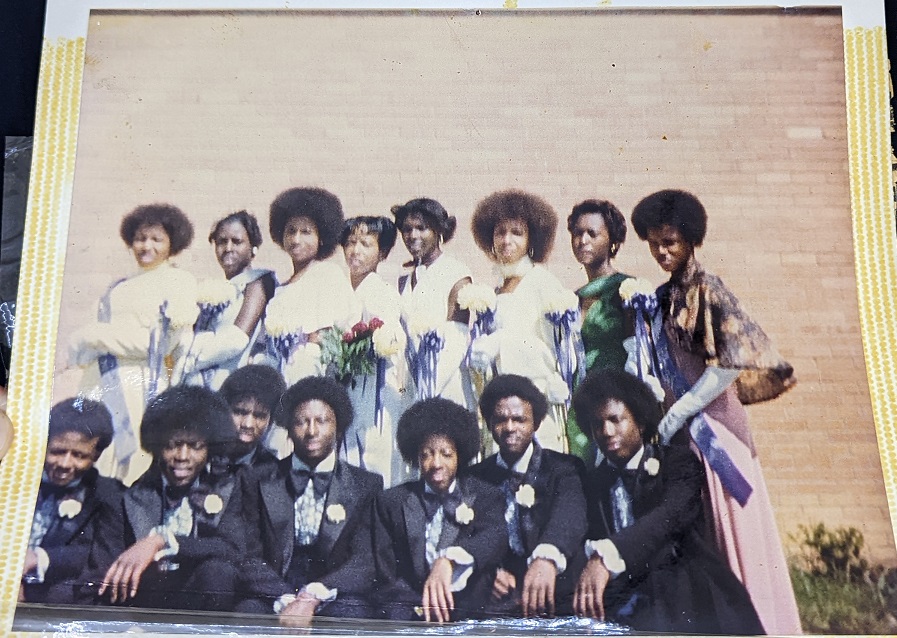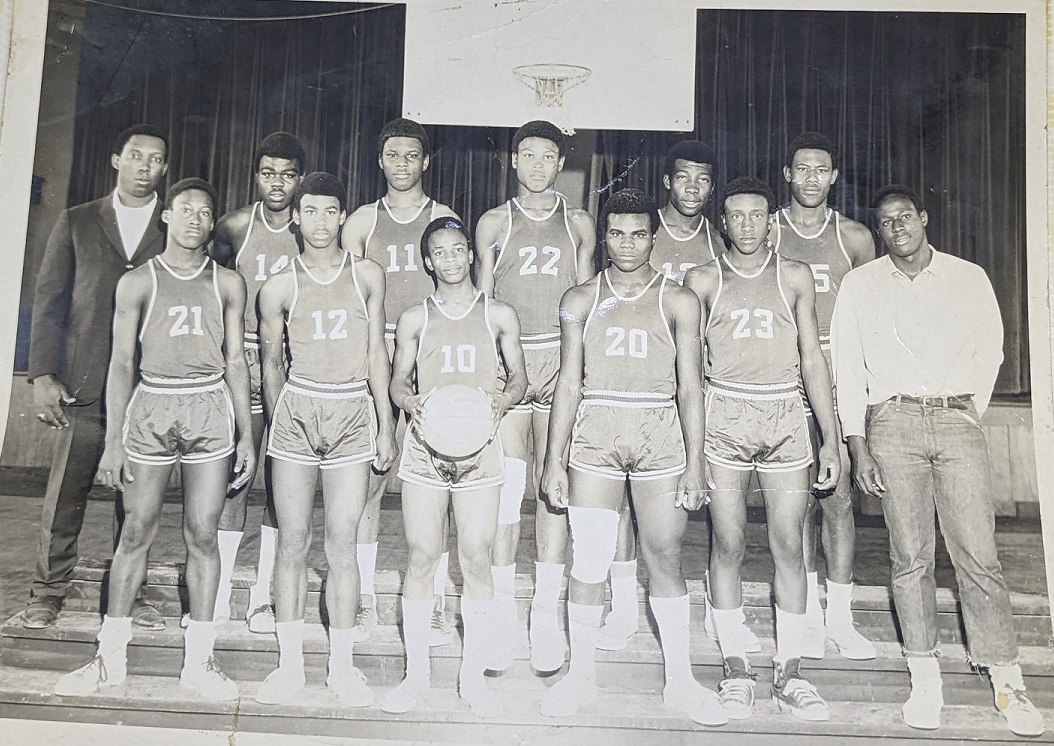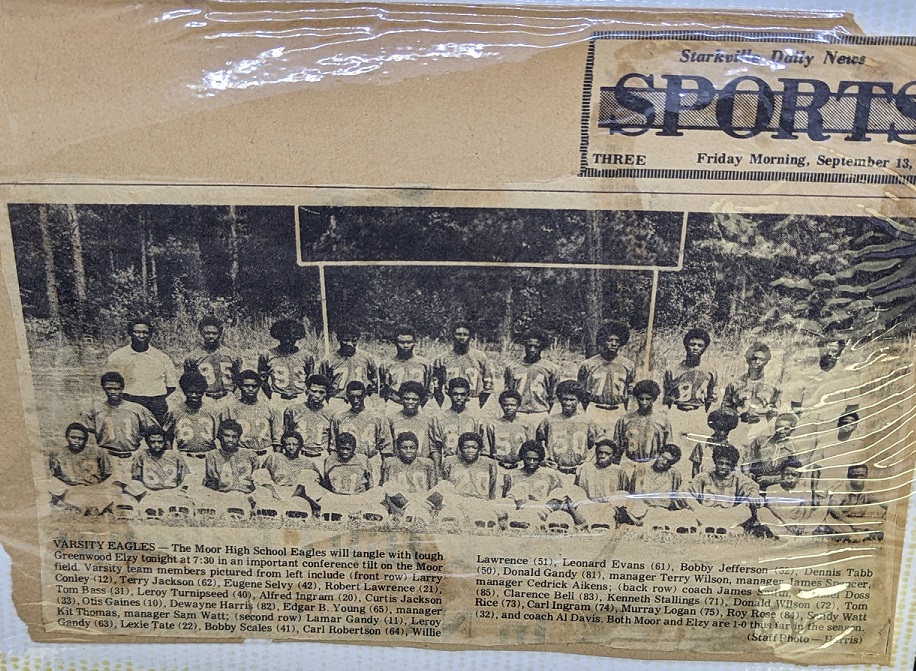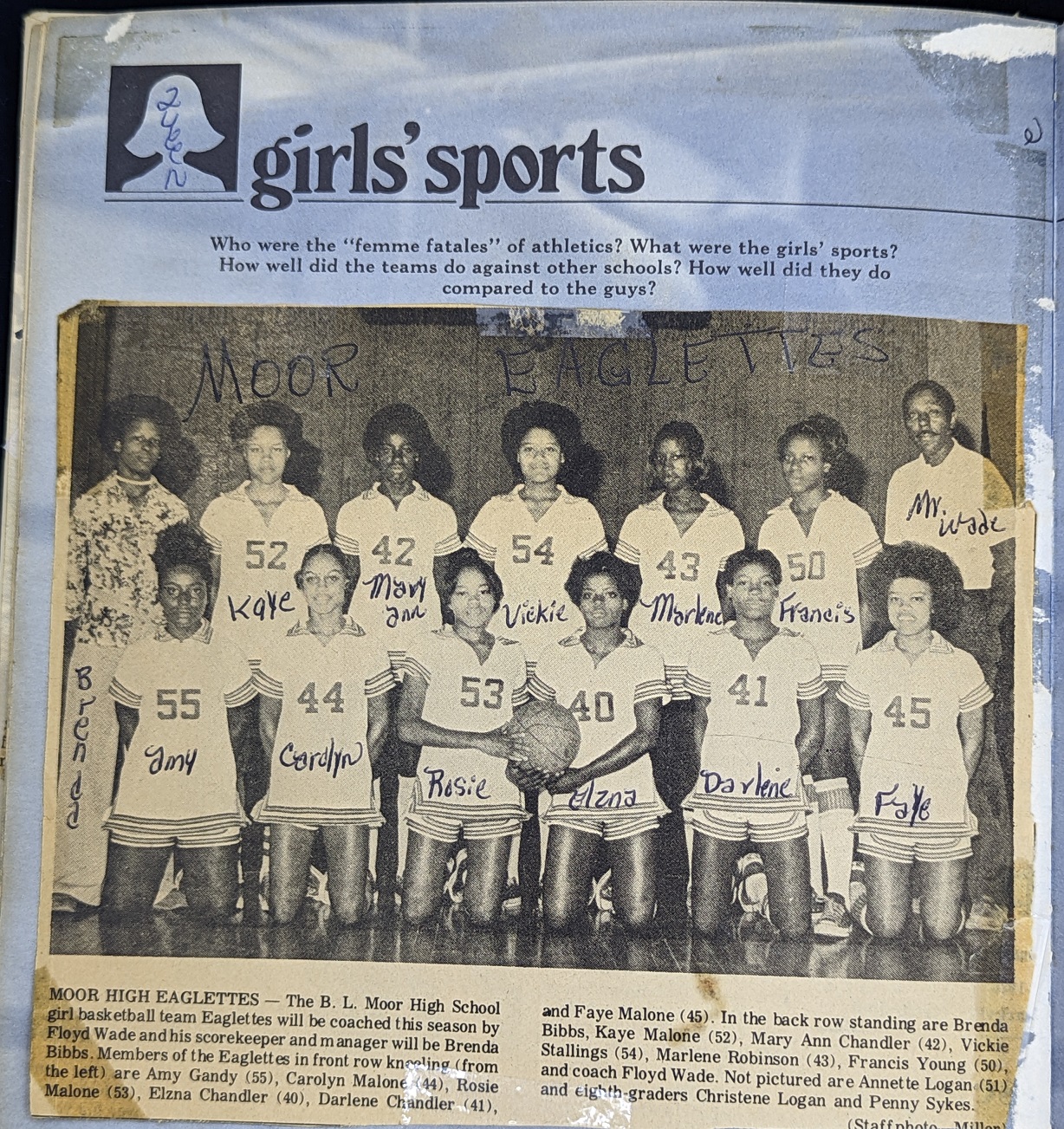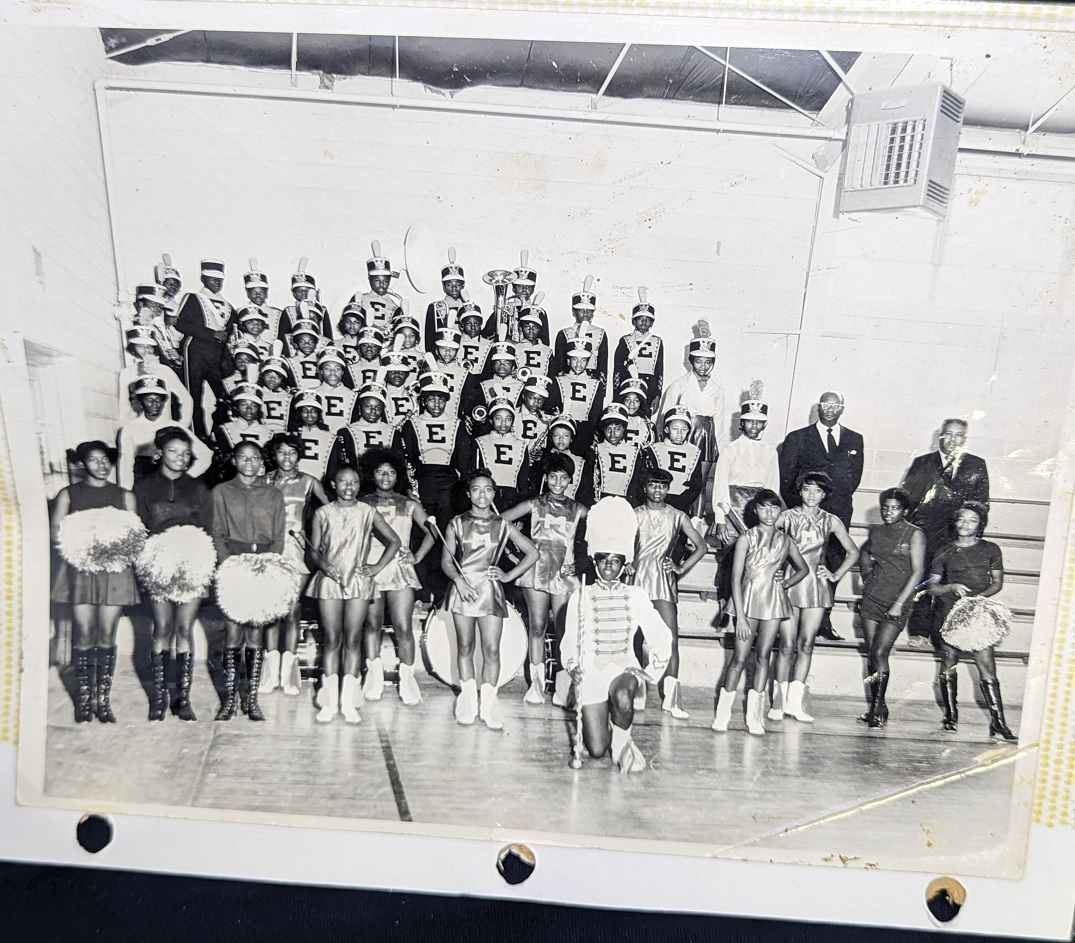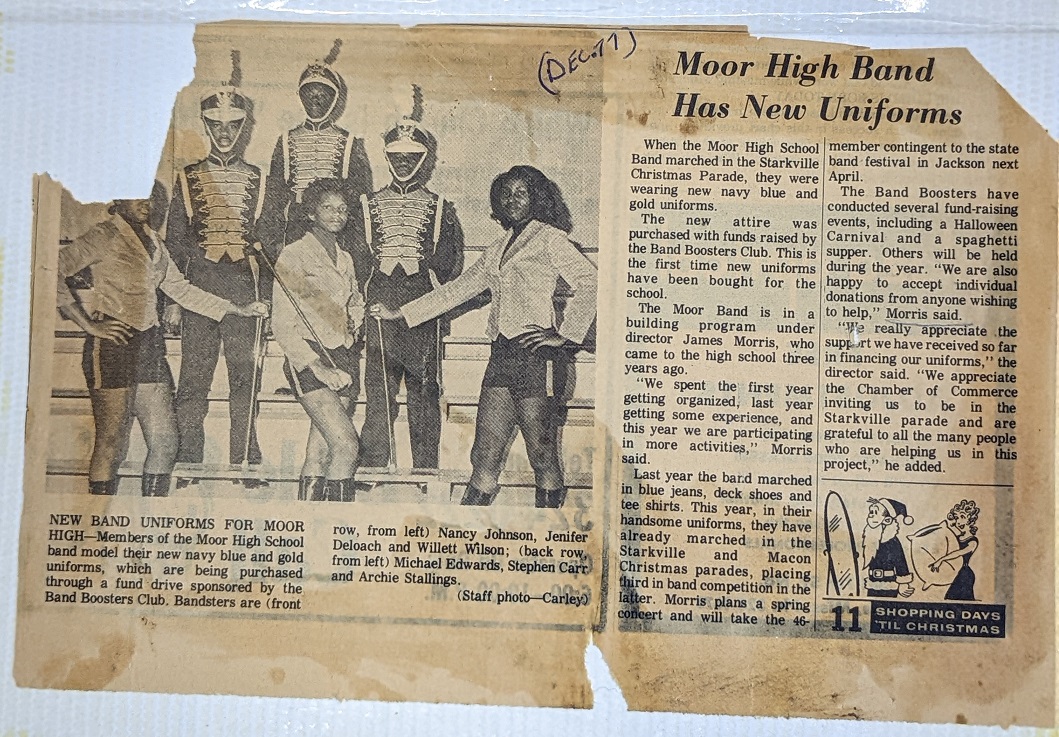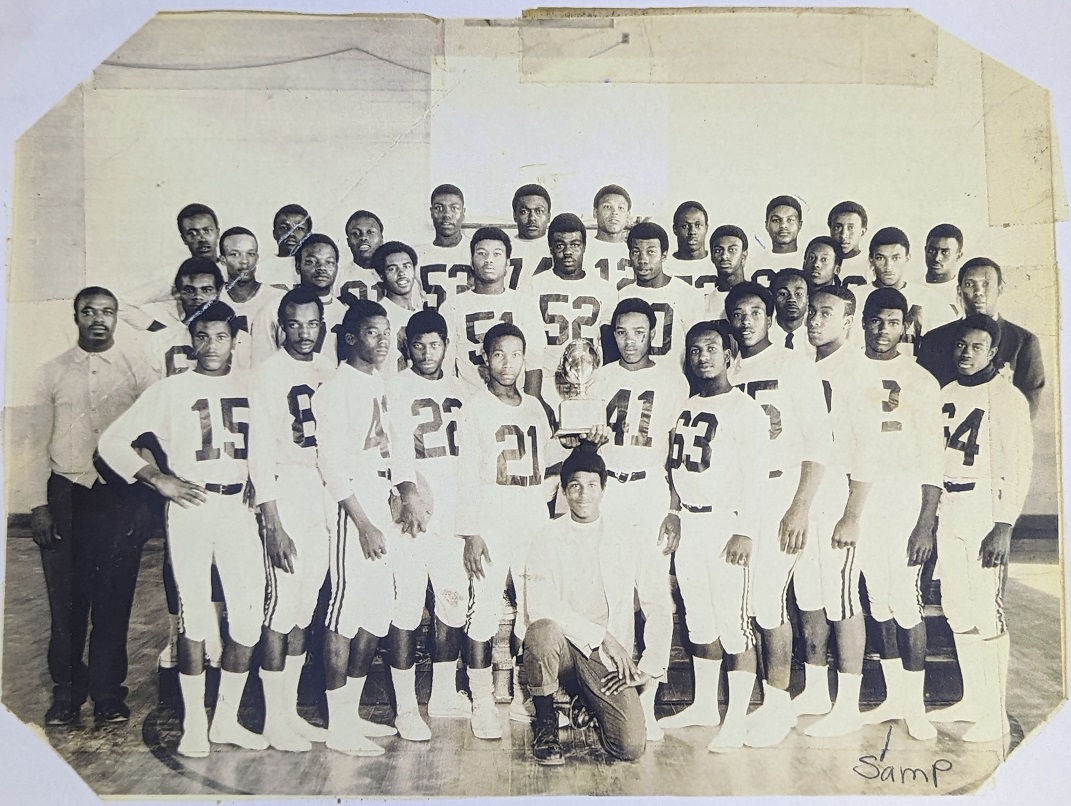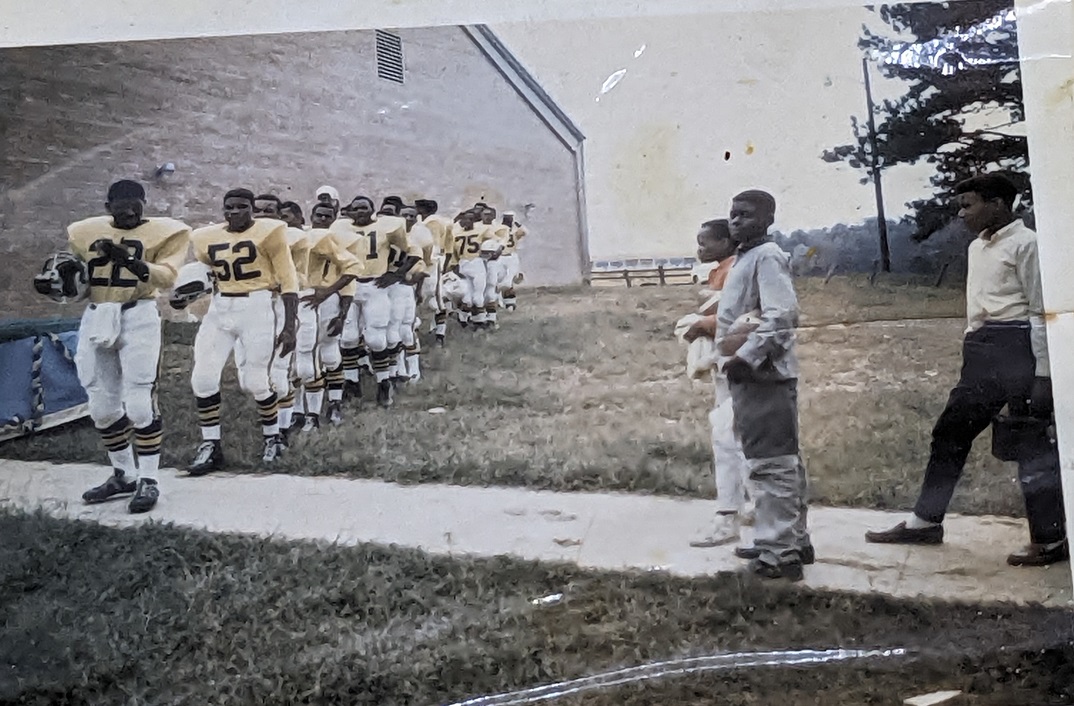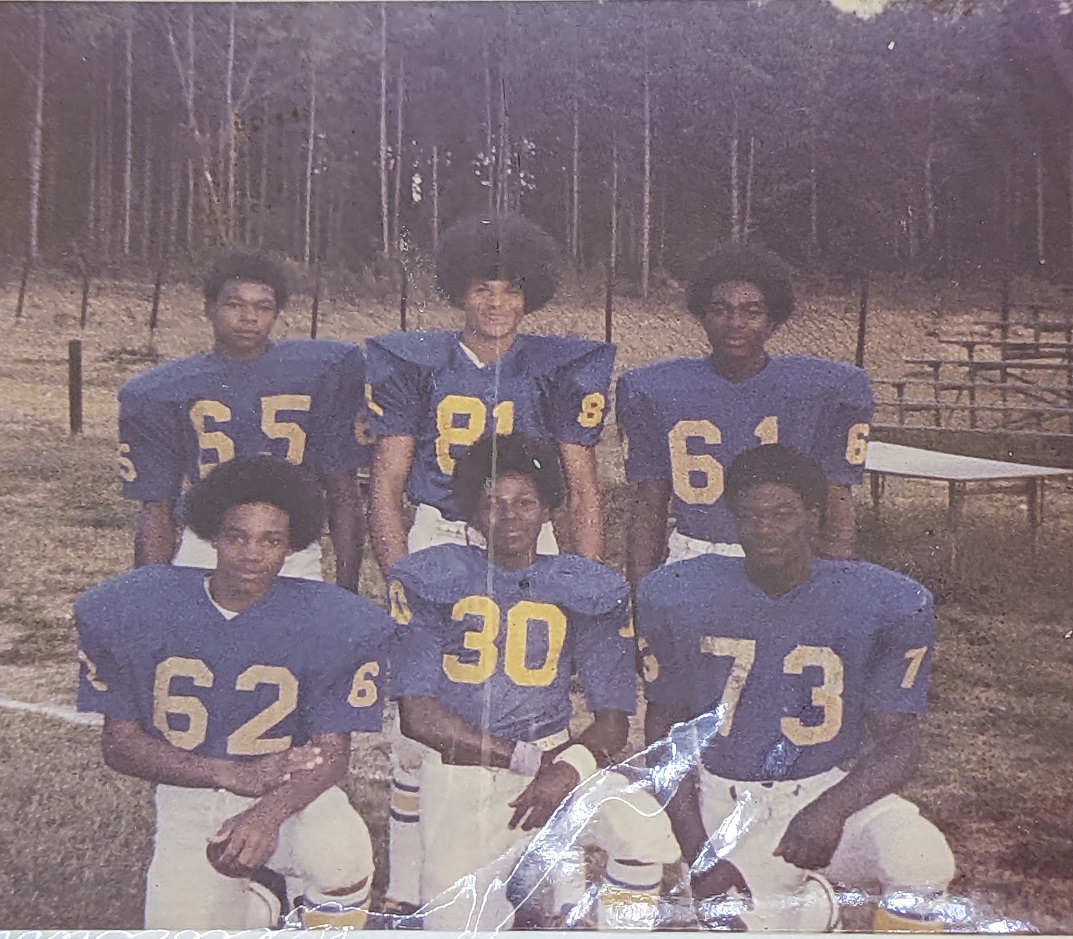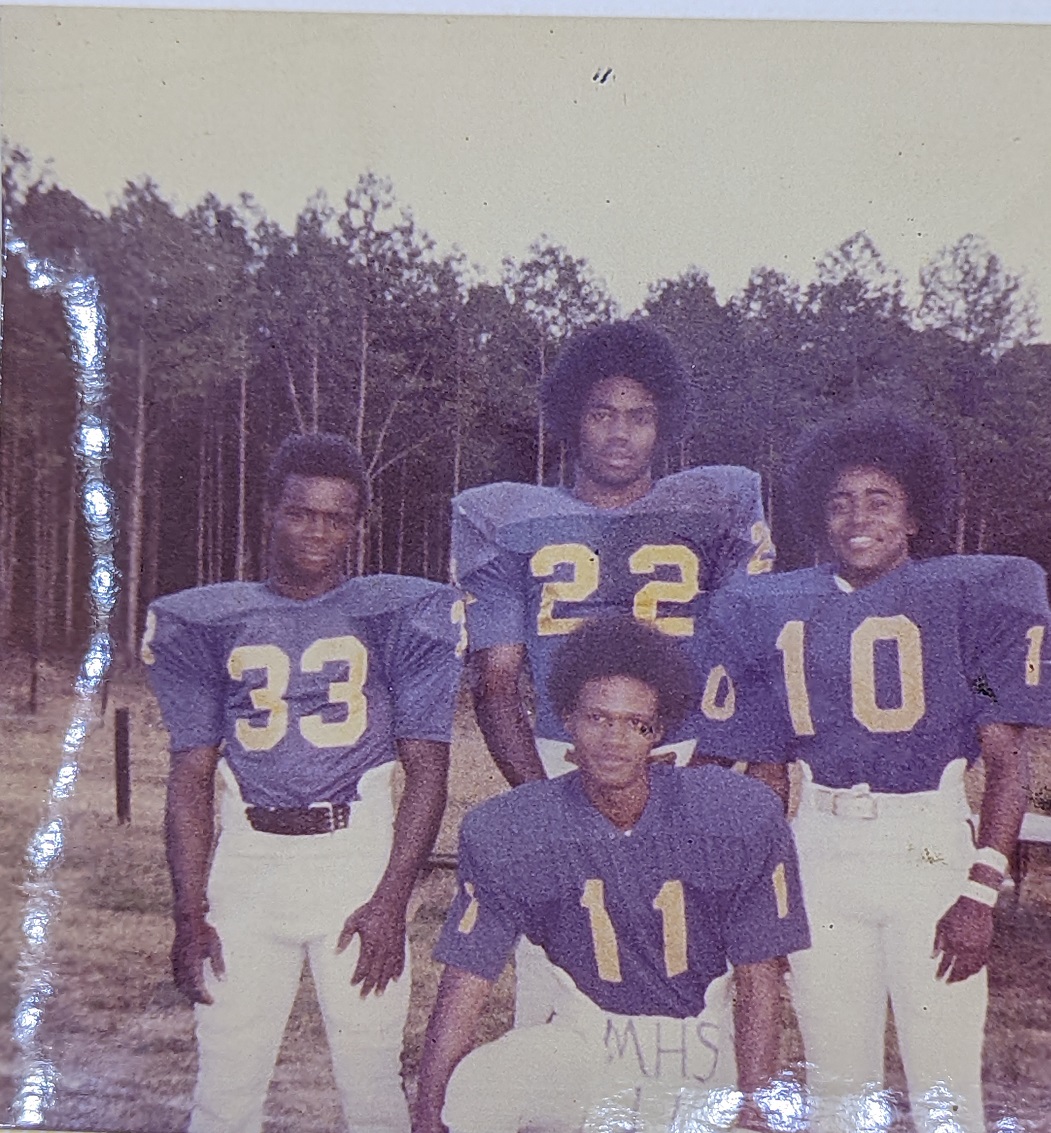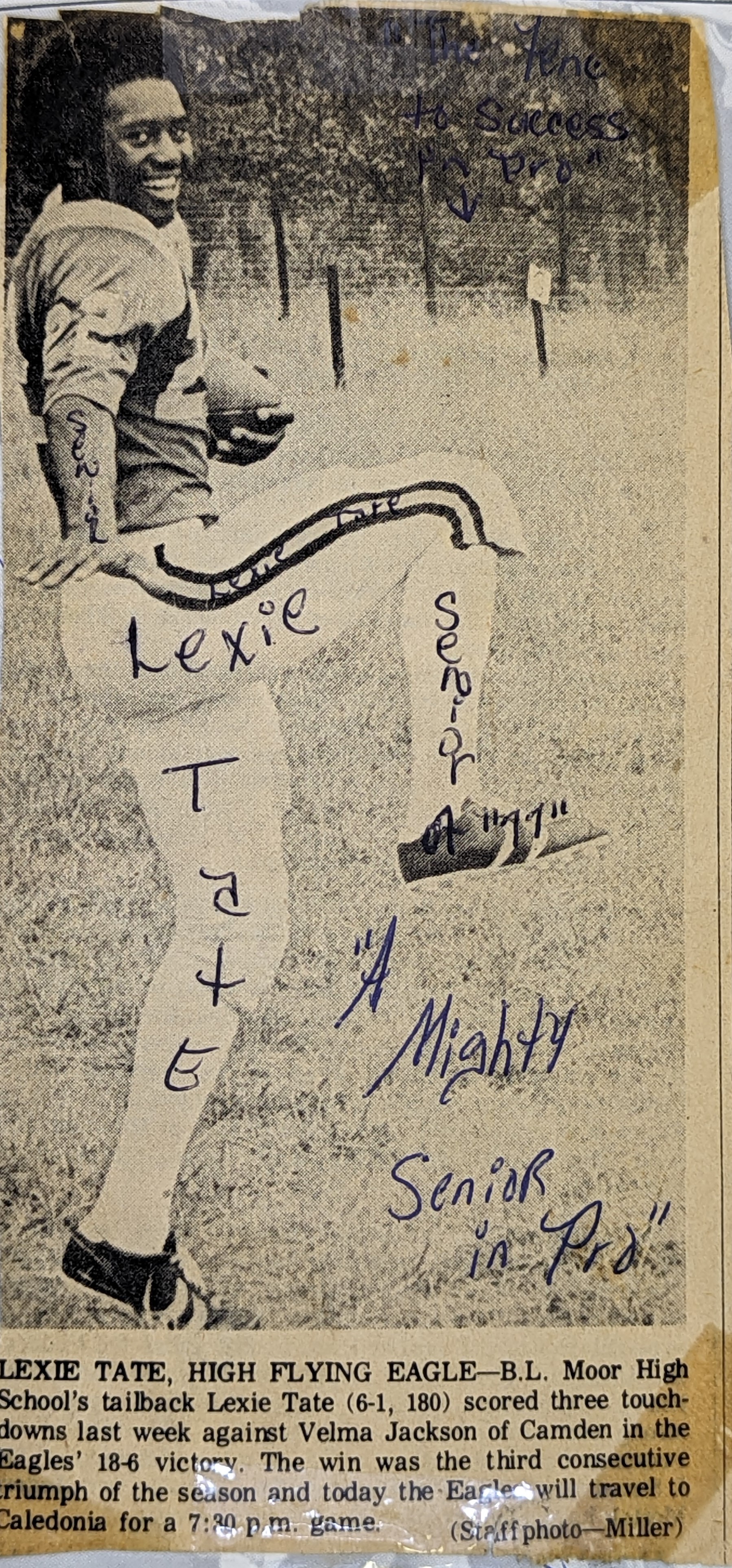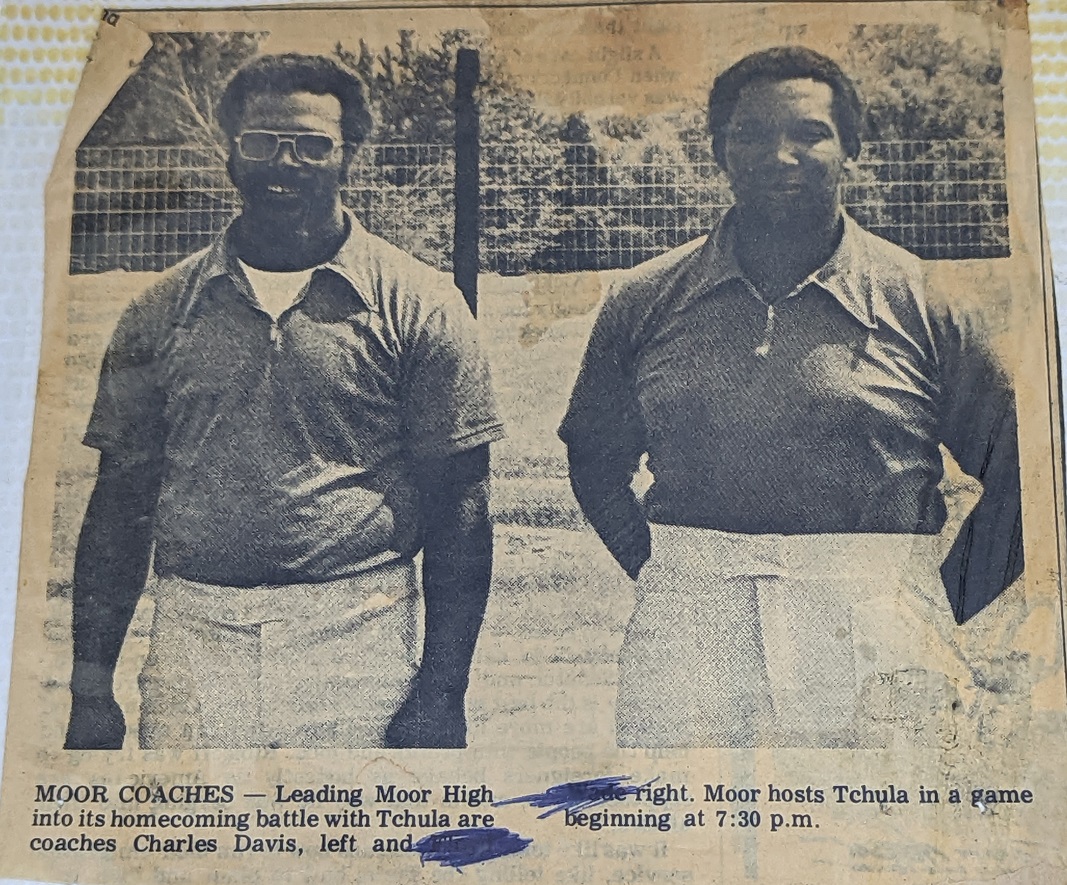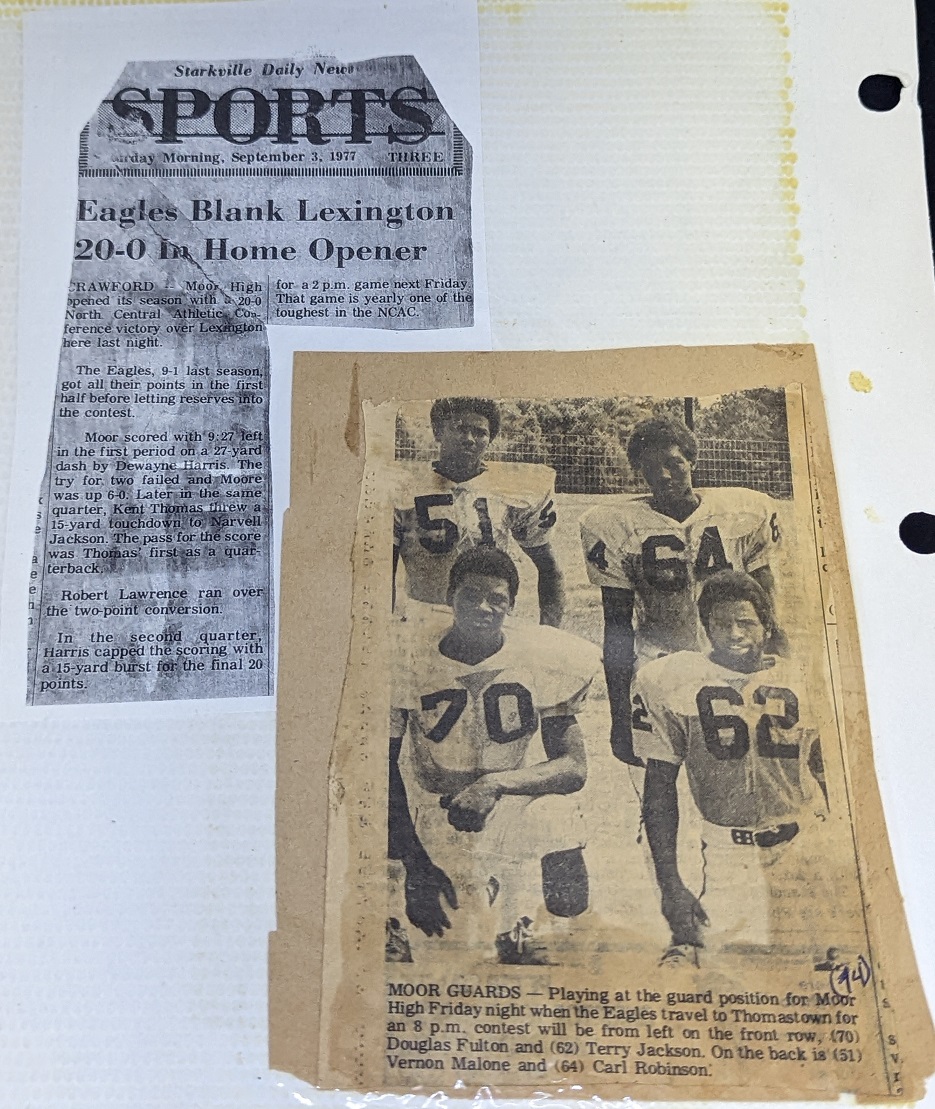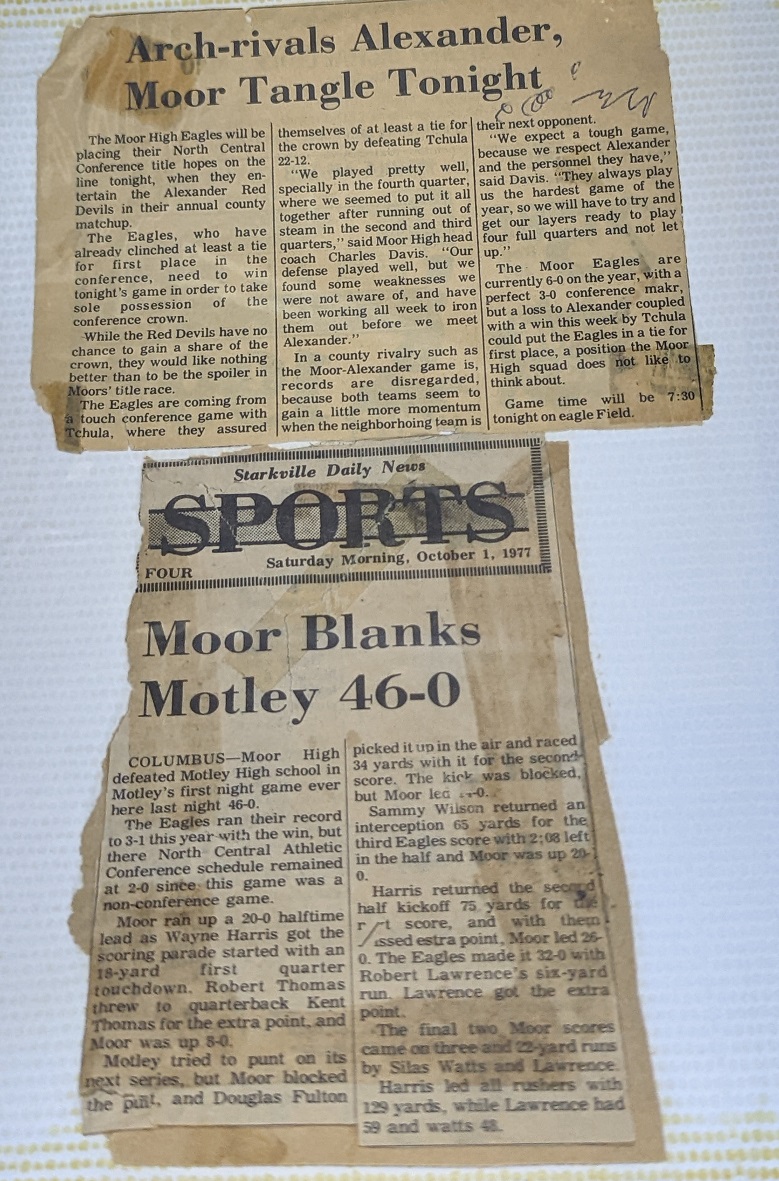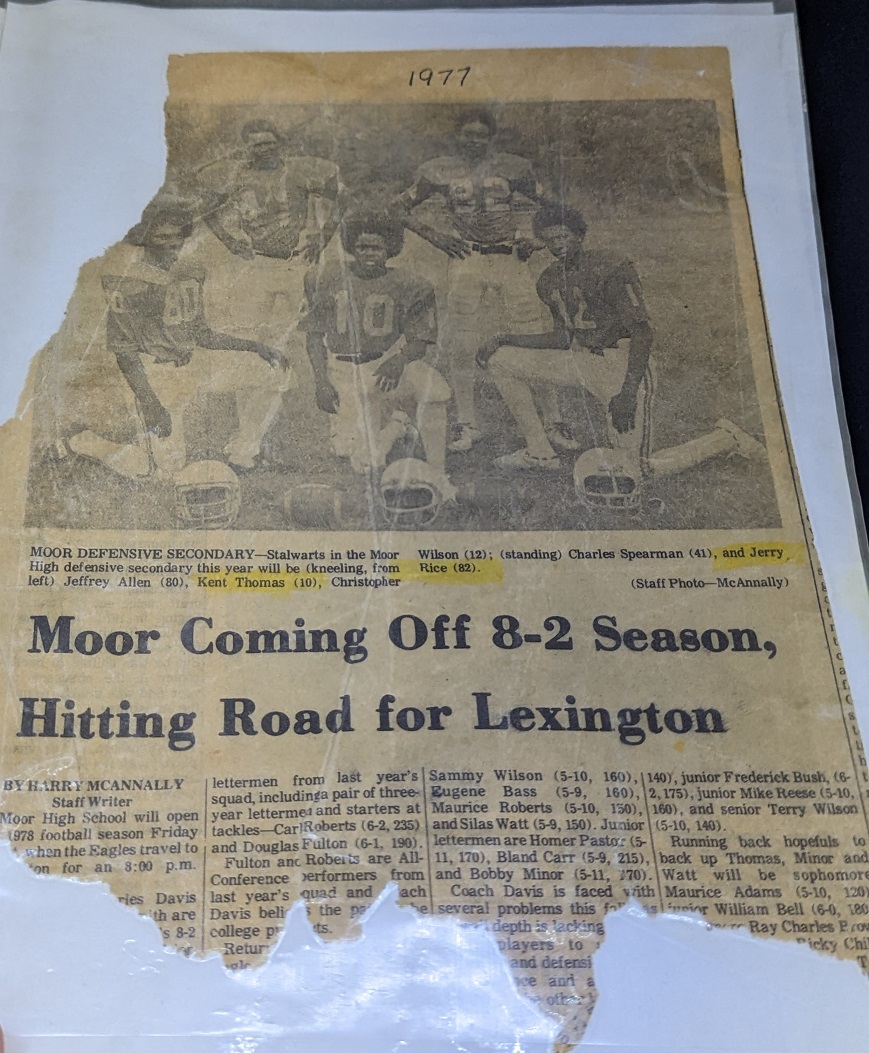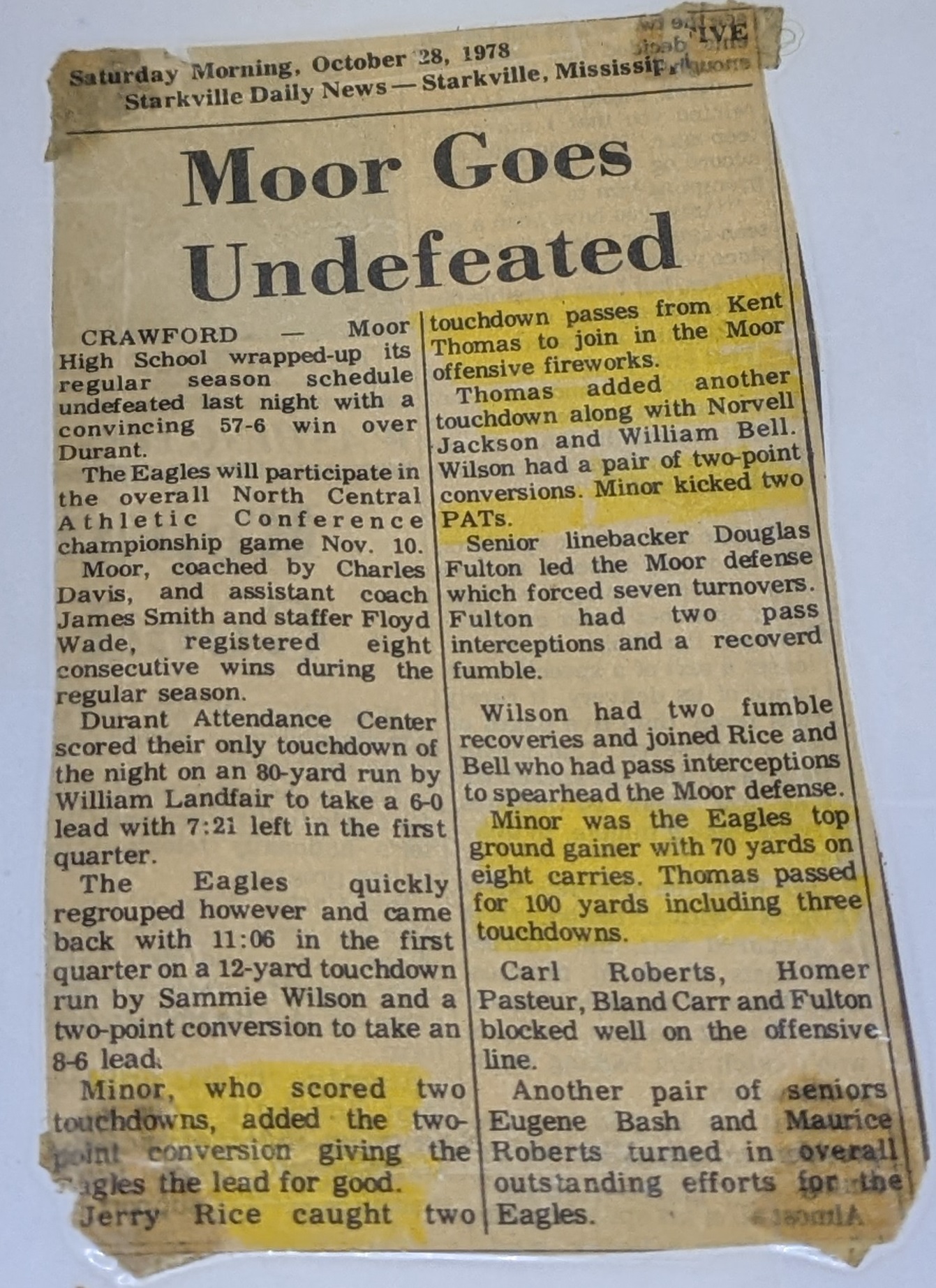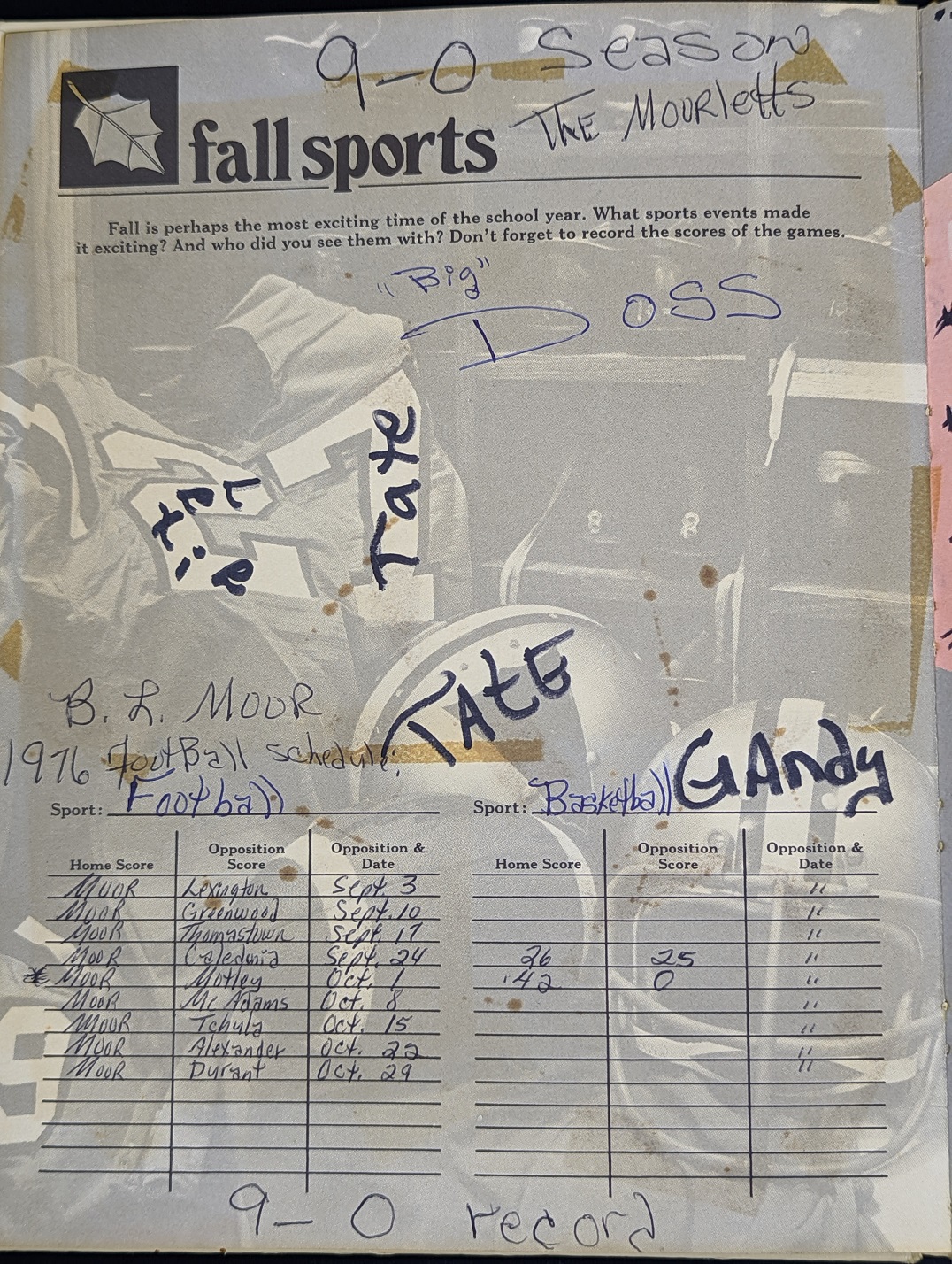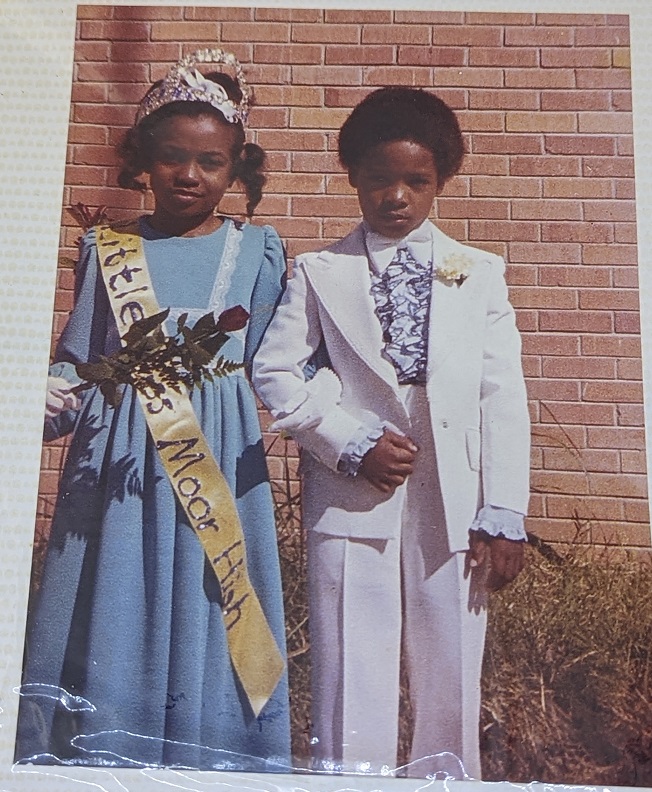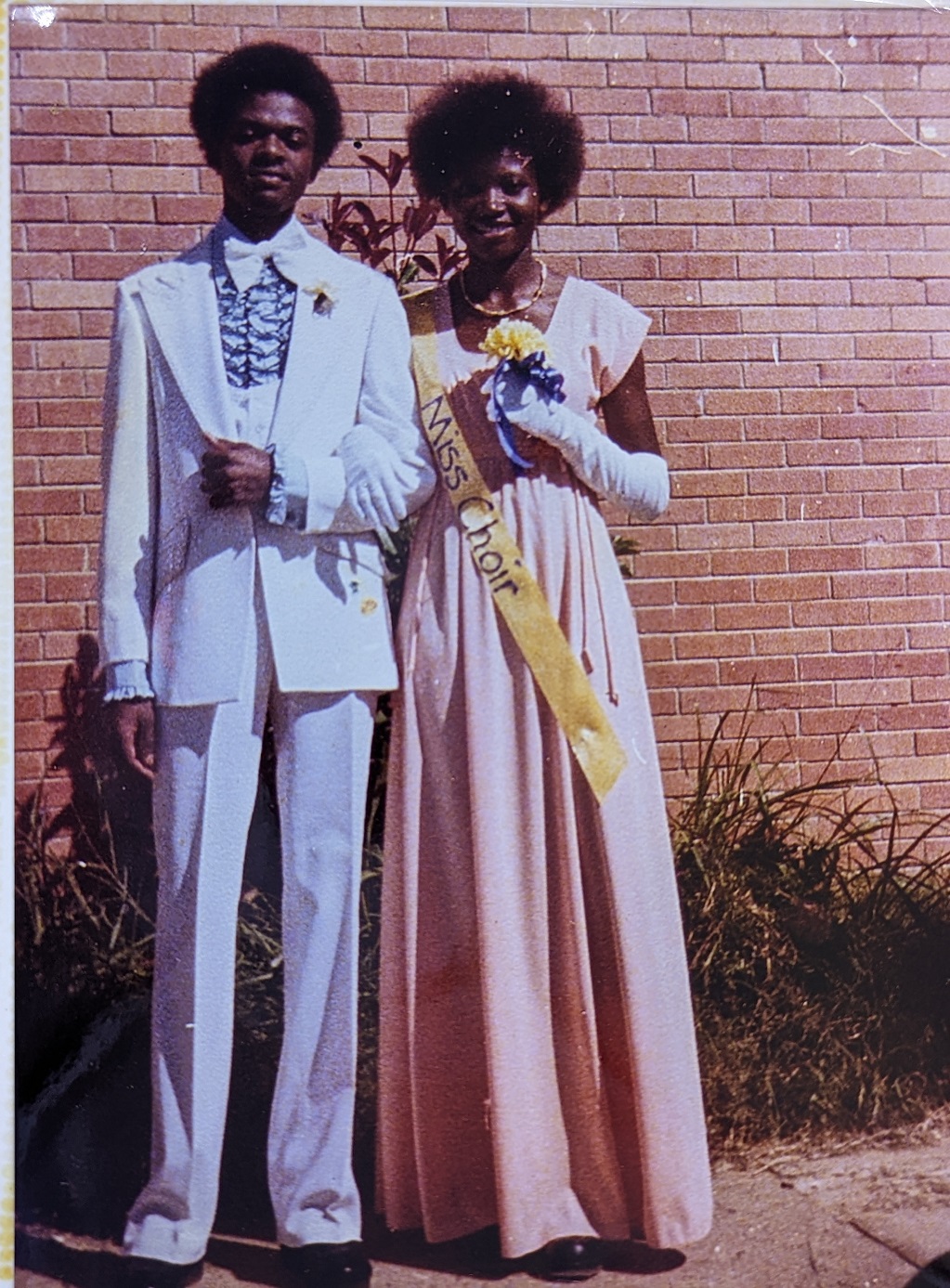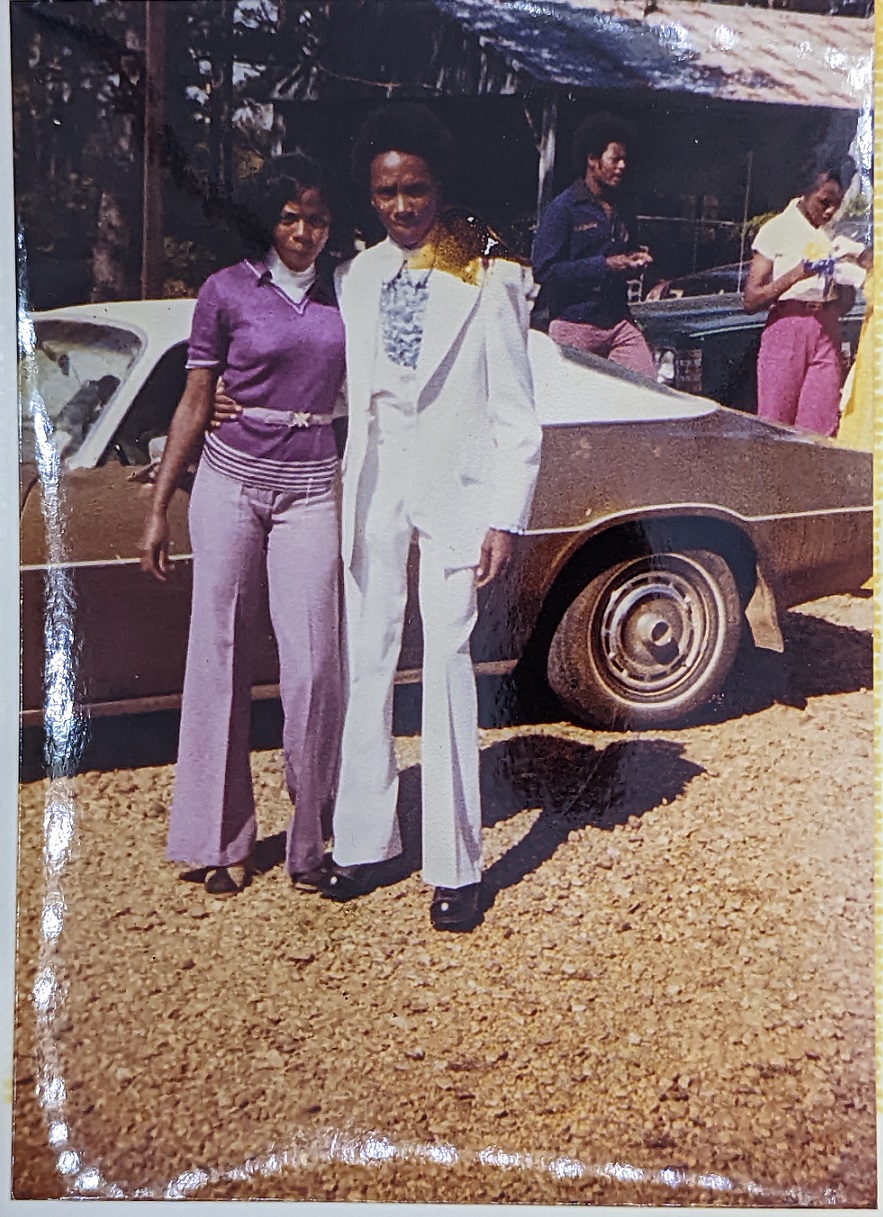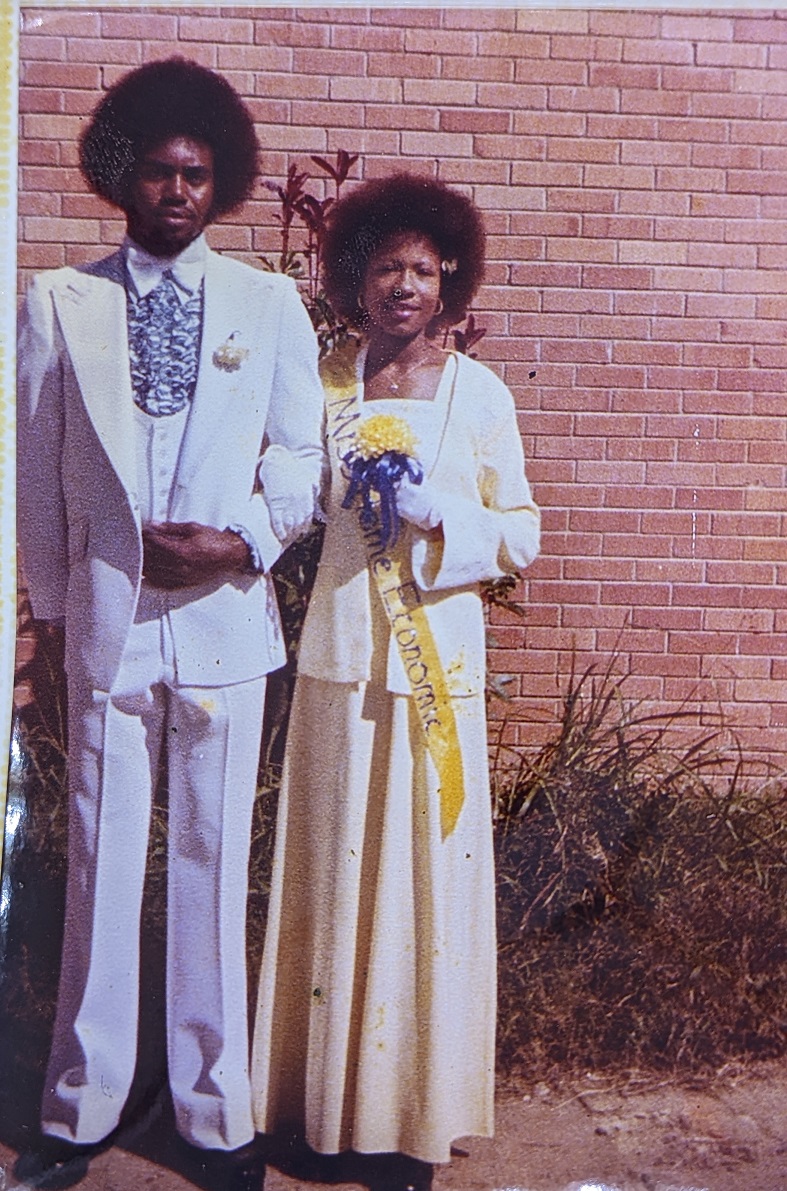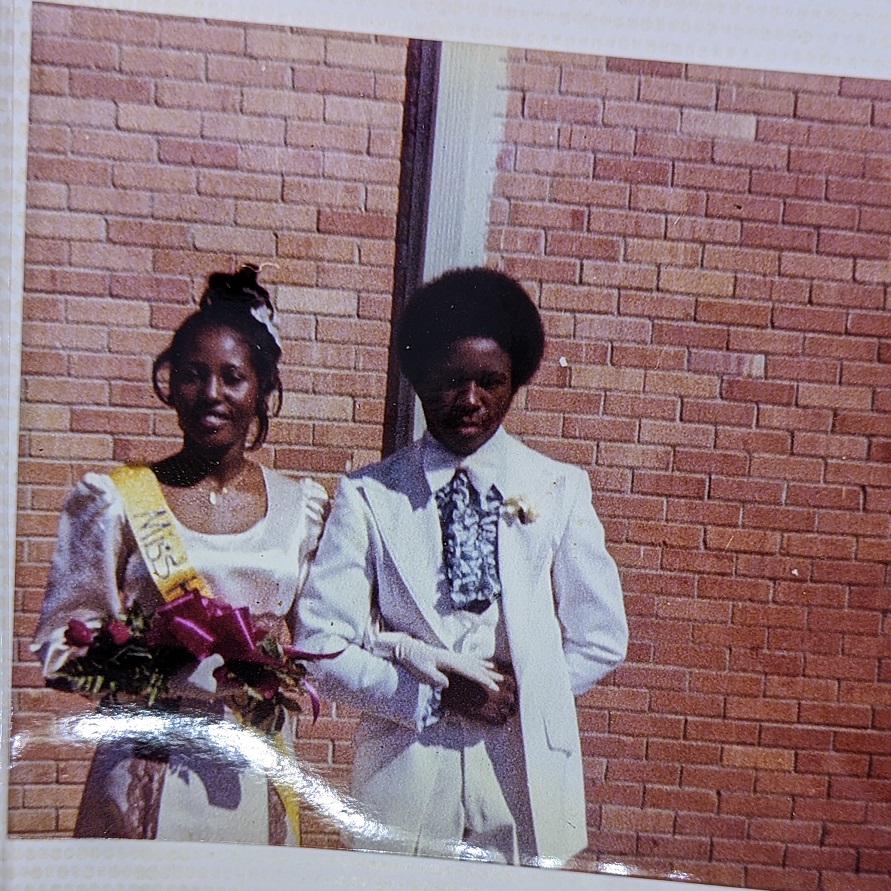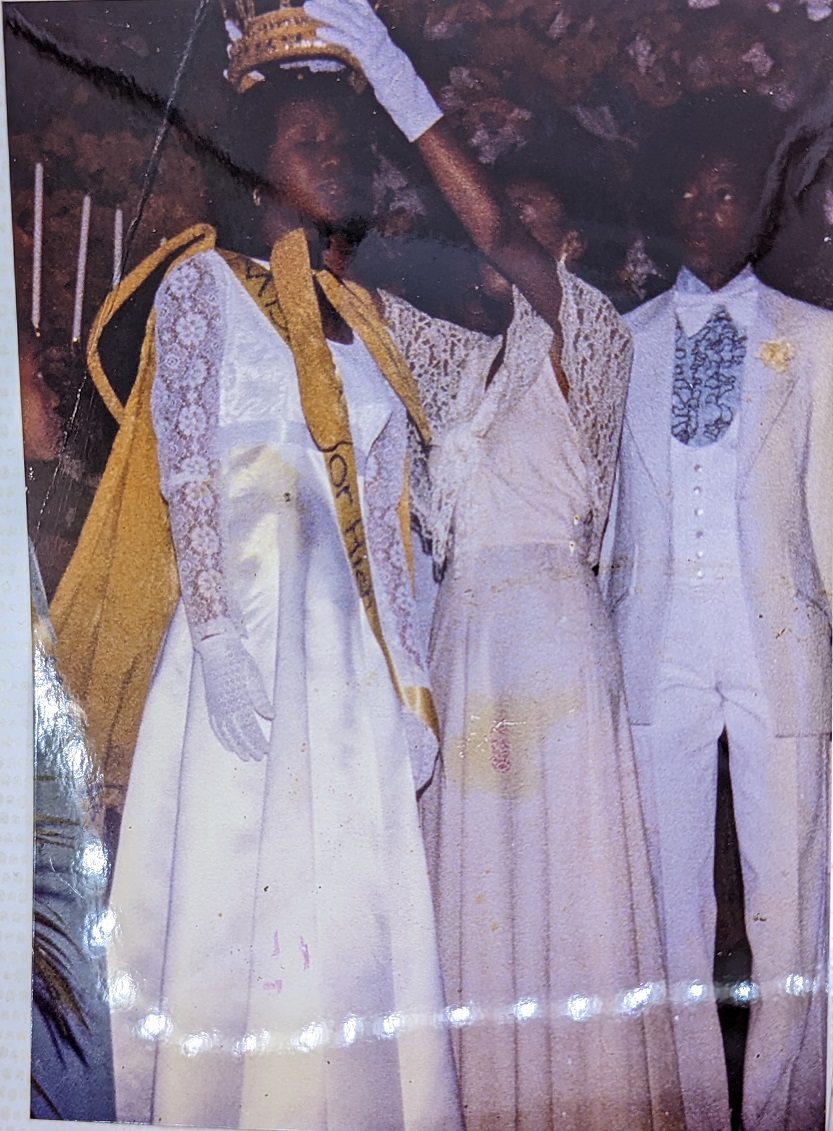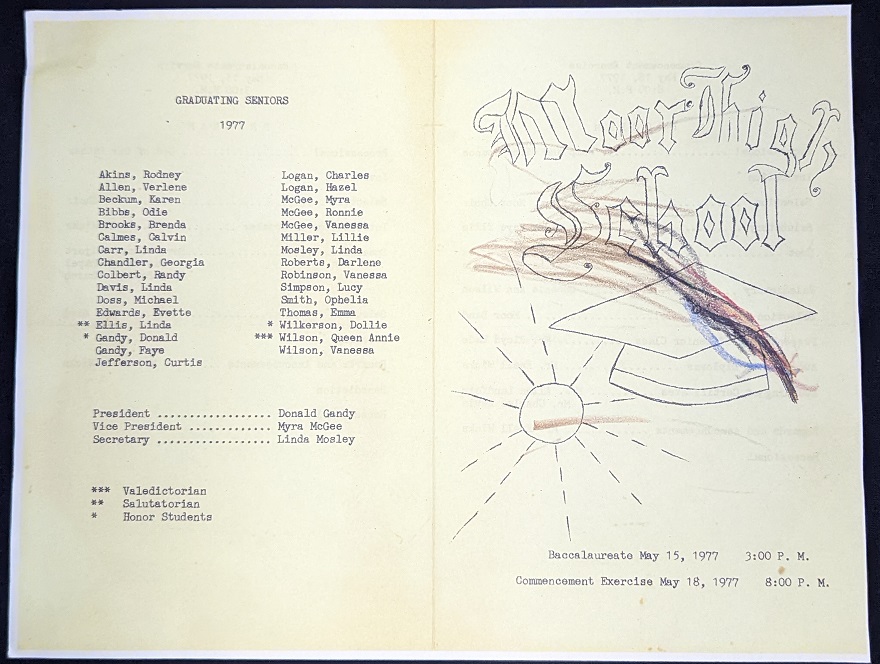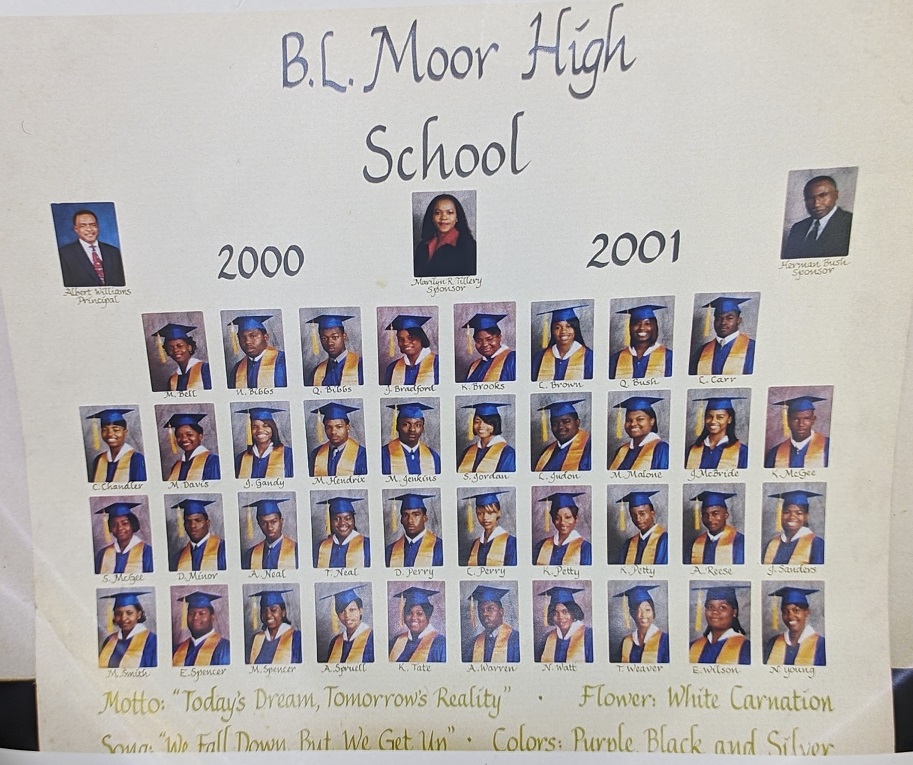Contents: Desegregation | Beginnings of B.L. Moor | Campus Life | Alumni Reflections
BL Moor High School Legacy
B.L. Moor from 1960-2015
Desegregation
In 1953, former Governor Hugh White called the Legislature into extraordinary session and eventually mandated that all Mississippi school districts be reconstituited and reorganized; consequently, in 1959, construction for the Pleasant Grove and Rock Hill Projects began. The Rock Hill Project, named after another communtiy school, became known as Alexander Middle School, while the Pleasant Grove Project was named B.L. Moor, despite the local community’s desire to retain the name “Pleasant Grove.” (MDAH.
Between Governor Hugh’s mandate and the construction of B.L. Moor, the Supreme Court passed Brown v Board of Education, a monumental ruling that stated separating children in public schools on the basis of race was “inherently unequal” and unconstituitional. Integration, however, was virtually non-existent a decade later, as not a single Black child attended an integrated public school by 1963 and only 1.2% of Black students were integrated by 1964. It was not until after various pieces of legislation were enacted did change occur. These include the 1964 Civil Rights Act that threatened to cut off federal educational funding for segregated school districts, as well as the funding for the Department of Health, Education, and Welfare in 1966. Additonally, the Supreme Court’s decisions in Green v. County School Board of New Kent County(Virginia, 1968) and Alexander v. Holmes County Board of Education(Mississippi, 1969) helped put an official end to segregation.
B.L. Moor’s student body, although desegregated, remained entirely Black. A large part of this was due to White flight, for many southerners remained refractory to legislation, causing 115 new private instituitions to appear in the state, such as Starkville Academy. As the charts show below, private school enrollment in Mississippi nearly tripled between 1967 and 1972. Astoundingly, before the final consolidation of East Oktibbeha County High School (which B.L. Moor consolidated into in 2002) into Starkville Oktibbeha schools in 2016, the county school was still over 90% Black, while Starkville Academy was well over 90% White (Charles Bolton, The Hardest Deal of All; Charles T. Clotfelter, “Private Schools, Segregation, and the Southern States”; National Center for Education Statistics. Richard Grant, “Starkville school merger: What went right?”.
Beginnings of B.L. Moor
Regardless of the social inequalities, B.L. Moor students were excited about the opening of the school in 1960. They looked forward to indoor toilets, hot meals, the new gymnasium for basketball, and not having to cut wood for heat. Allen M.S. Landfair explains the difference, saying,
We had left a three-room church school at Ebenezer Baptist Church where we had oil wood floors, a potbelly heater which was fueled by wood which the boys gathered coal. Our lunches came from a brown bag which we brought from home, so we were delighted to be at a new school with tile floors, brick walls, departmentalized classrooms, and a cafeteria which served hot meals.
While there were numerous advantages in the opening of B.L. Moor, there were still areas for improvement, such as transportation, as multiple students still had to walk to school if they were not commuting from Crawford. This original building had numerous classrooms, a home economics department, a business center, a library, and cafeteria. One of the most memorable elements, however, was a hallway that extended a considerable distance and was divided into three sections to accomodate all grades K-12. One student recalls their experience of the new facilities on opening day, saying,
Can you imagine? The hall was well waxed and long. As one stepped inside the front entrance there was a huge gymnasium with a sparkling wood-stained basketball court. Behind it was a stage that would be used for general assembly, special programs, or other unique events in the community.
Josie Malone Redmond similarly recalls the new buildings size, remarking, “I remember walking into what appeared to be the largest and most beautiful building I had ever seen.” Ules Young, class of 1960 - B.L. Moor’s first graduating class, also expresses strong emotions at the opening, saying it was like “a whole new world. There were larger classrooms, science labs, typing room, and gymnasium. The principal and secretary each had their own office,” while Redmon commented on other “opportunities that did not exist,” such as “certified teachers in specialized subject areas” and a student counselor. But the building and its resources were not the only thing that made it special for the students, as Rosella Harris-Austin found attending the new school with her friends from Chapel Hill and “riding a new bus, making new friends, and experiencing new teachers” were equally “breathtaking.”
Mr. King served as the first principle and one of the first history teachers, but was known “for his work at Blackjack Junior High School” beforehand (Jimmy Blair, Sr., Class of ‘64). King’s impact extended beyond the classroom, though, as Blair states he was “instrumental in getting the communities together for boys and girls basketball tournaments [and] was one of the first to use outside lights outside for night basketball as well as the two-pole basketball.”
A year after its opening, E.N. Wicks, after serving as Rock Hill’s principal for 6 years and as Alexander High’s first principal, took Mr. Kings position at B.L. Moor and became “the face of Moor High School” (Blair), serving as the principal for a total of 20 years between 1961-1981.
And while B.L. Moor’s opening may have felt like a new world, breathtaking, or the beginning of a new era, Johnny Malone, as part of Pleasant Grove’s last graduating class in ‘59, said the two schools were like mother and child. They can separate, but the blood line is forever.
Campus Life
Just as the teachers instilled various skills in students, extracurricular activities provided students with life-applicable characteristics. For example, Joyce Bell-Collins, the class of ‘68, reflects,
One skill I grasped was to compete, when I excelled at sports at Moor. The demanding work to perform well has been beneficial throughout my life. Competitiveness covers a wide range of skills in everyday life; for example, the desires to achieve, and to make good decisions are traits I inherited.
Aside from acquiring additional skills, B.L. Moor alummi found extracurriculars and events to encompass a major portion of their high school memories. The establishment of these extracurriculars, however, was particularly meaningful since they were unable to sponsor certain sports prior to 1960.
Basketball
One exciting feature for the newly established basketball team was the brand new basketball court, which allowed new, unqiue experiences. As Allen M.S. Landfair says, basketball “allowed us to participate before crowds” and “built our self-esteem and physical and social development.”
Before the exhilirating and challenging games, the tryouts themselves could be daunting. Phyllis Curry-Tate, class of ‘74, for example, explains how tryouts were “stressful [and] nerve-racking.” She said she would “walk toward the bathroom each year to check the posted listing for the final selection [and her] heart raced with double beats; however, through hard work, diligence, and perseverance each year, [she] made the team.”
In the 1962-1963 season, one of the Eagles first basketball teams, Jimmy Blair Sr. remembers his mother coming into the gymnasium to see him and his two brothers, Charles and Robert, play alongside their friends Charles Akins and Bobby Tate. After E.N. Wicks gave his mother the “best seat in the house,” Blair remembers her saying, “Shoot it, Jimmy!” or “That’s my baby!” while “beaming with pride.” Blair says the season was filled with success, “beating schools twice our size.”
Walter Conley elaborates on being a starter the ‘63-‘64 season, positing, “My most memorable event at Moor High School was a basketball game during my senior year. That game was a success. I scored nine (9) points and played a major role in the team defeating Hunt High School of Columbus, Mississippi. The next morning when I got to school, my popularity as an athlete was off the charts.” As a Junior, Waddell Grayer mentions his performance brought similar fame, saying, “My most memorable experience was in the tournament we won in 1964 when I scored 24 points. There should have been a police escort that night with such popularity.”
Allen M.S. Landfair said that Coach Wade “wonderful person,” and “served as a father to his players.” Moreover, she recalls, “During the holidays, he would pick us up in his Beetle Volkswagen. It was amazing how many of us could cramp into his Bug. Our parents had complete trust in Mr. Wade.” Coincidentally, Landfairs husband, Joseph Landfair, later became the girls and boys head basketball coach and acquired the most wins in school history.
Some basketball team and player achievements include:
- 1988: First Men’s District Championship.
- 1992: First Men’s appearance in the North State Playoffs.
- 1992: Men’s Runner-Up in North State Playoffs.
- 2002-2004: Newly consolidated Titans make first appearance in state playoffs in Jackson, Mississippi.
- Back-to-back, 2003-2004, District Champions.
- Patricia Stallings Jenkins signs to Mississippi State.
- Imes Jackson becomes the second Eaglet to play with Mississippi State.
- April Sykes receives athletic scholarship to Rutgers University.
- Janeiro (Scooter) Bush receives an athletic scholarship to Jackson State University.
Band
Once the band was established in the late 1960’s, director W.B. Jones conducted them in local functions like the annual Starkville Christmas parade, the Rust College parades, and chapel concerts. Initially, the band did not have uniforms, so they often wore plain black or blue pants with white tops, but in 1972, after a student wide fundraiser, the first band uniforms were purchased from a rival school - Amanda Elzy of Greenwood. Although the uniforms were not the school colors of blue and gold, students were prideful with their newly acquired attire and marched with a newfound dignity. The uniforms can be seen below.
Director W.B. Jones, who happened to also teach history in both middle and high school, would introduce students to flutophones in 6th grade and taught how to read music before transitioning to perfomring in local events. Outside of the flutophone, common band instruments were unavailable, so students would acquire a payment plan from a local business to acquire the necessary instruments.
In 1977, five years after acquiring their initial uniforms, director James Morris acquired the appropriate blue and gold colored uniforms after organizing a few fundraisers. The article below provides further details.
Maurice Robinson, class of ‘74, said “Moor High made me realize my talents. My performance in the marching band as a drummer, learning to perform with various instruments [was one of] my most memorable experiences.” Similarly, Marcia Lawrence-Patrick, class of ‘75, says B.L. Moor granted her the opportunity to learn and play music and that she appreciates W.B. Jones’s dedication and insight to various types of music.
Yvonne Ellis, class of ‘75, recalls, “I had been a member of the Moor High Band since I was in the 7th grade. I enjoyed every minute of it. There were times I wanted to quit, but something always changed my mind. I am grateful for the opportunity to gain experience of music and be part of the marching band.”
Football
The desire for a football team dated back to Pleasant Grove, but it was not until 1967 that the first team, under Coach Charles Davis, was actualized. The two pictures below showcase some of the first B.L. Moor football teams.
Football quickly became a beloved sport for the school, and the pictures speak to the friendships and personalities surrounding the team year after year.
A decade after the team was established, B.L. Moor had a successful season, finishing with an 8-2 record. Charles Davis and Floyd Wade were the Head and Assistant Coach, both are pictured below.
One year later, in 1978, Moor had one of, if not the most successful seasons to date, as they went undefeated (9-0) before losing to Cleveland East Side in the East Central Athletic Conference championship game. This team had the help from the schools most famous alumni - Jerry Rice - who was only a sophomore at the time. Rice had a particularly good senior season when he was named an All-State Wide Receiver.
Charles Wicks, son of E.N. Wicks, gives a special tribute to Coach James Harold Smith by relating a story where he encouraged him to try out for the team.
Homecoming
Alumni Reflections
Upon reflection of their days at B.L. Moor, virtually all alumni commented on the positive impact B.L. Moor educators had on them, as well as the countless life-long friends they made during their school days. Although the building’s size was commonly noted, the classrooms were small and this established a “close” and “family style” place “where everyone knew one another [and] you could feel and see the concern people had for each other” (Helen M. Odom, Class of ‘72).
Various alumni described their teachers as “encouraging,” “caring,” and “dedicated,” to name a few of the reoccuring adjectives used (Willie E. Thomas (‘73); Kenneth Stallings (‘78); Lodina Evan-Peterson (‘71)). Many almuni also recognized the impact their teachers made on their futures. Whether that was molding them into “a productive and caring citizen,” directing them to “go forth and explore the unknowns of the world,” or preparing them to “excel [and] suceed in life,” the educators found ways to ensure their students had the “knowledge, understanding, and life skills” to confidently “move on to the next phase in life [without] uncertainty or fear” (Dorothy Pearl Rice-Johnson (‘71); Helen M. Odom (‘72); Allen M.S. Landfair (‘67); Jacqueline “Jackie” Ellis (‘74)).
One story from ‘67 testifies to the adiministration’s caring and dedicated nature is whenever a group of students marched into E.N. Wicks office and demanded for new buses, as broken windows allowed wind and rain to enter and with it being colder weather, the students found it unbearable. Mr. Wicks listened and called the presiding superintendent, Mr. Ware, and explained the situation. Within a matter of weeks, possibly days, they received new buses. Mr. Wicks promptness attests to his concern and attentive nature that the students consistently recall and admire, as well as to why the student-faculty rapport was considered mutually respectful. Outside of listening to theirs students’ needs, teachers and administrators also found ways to keep the school days lighthearted and interactive by hosting talent shows, Friday night basketball or football games, “a social” (meaning classes were let out after lunch on Fridays), dances, popcorn parties, or even a movie when affordable.
The teachers and students’ relationships were also unique because teachers were familiar with the students’ families. Dorothy Pearce Rice-Johnson, class of 1971, recalls Mr. Floyd Wade saying, “I taught all your sisters and brothers and they all did good academically and I expect the same thing out of you,” which was often the case for many students whose siblings attended before them. Another example comes from Allen M.S. Landfair’s story of how E.N. Wicks carried her and her mother to tour Tougaloo College before she decided to go to Rust college on a scholarship. Such conscious efforts by the faculty to provide for the students and their families engendered special connections that radiated beyond the classroom and into the community; hence, B.L. Moor remains dear to many people who reflect on their high school experiences.
As aforementioned, many students commented on the impact educators had on their future lives, but the teahcers found an array of ways to influenced their lives. Akins-Taylor explained how the teachers’ “guidance and mentorship… inspired [them] to replicate those qualities in my professional career” and how the “discipline… was instrumental in the way I reared my children.” Whereas Vivian McGee-West, class of ‘79, says Mrs. Allen M.S. Landfair steered her into having “a thirst for more knoweldge about history, especially the African American place in society” which she carried with her to Jackson State where she “studied almost every class that related to black culture, history, literature, etc.” But one reoccurring theme was the alumni were inspired to become educators themselves. Hermon Bush, class of ‘62, mentioned the opportunity to serve on the board of education, as well as working as an administrator, coach,and teacher was something he was grateful for, as he could now serve “in the educational process of students.” Annie Love, class of ‘65, mentioned carrying E.N. Wicks statement “you’re going to miss those ivory keys” from whenever she was in school into her own teaching days. Allen M.S. Landfair, class of ‘67, says she returned within three years of graduating to be an elementary teacher and “grew to love the school even more.” Helen M. Odom, class of ‘72, says, “Having great teachers inspired me to become an educatro too.” And Billie E. Moody, class of ‘81, similarly refers to influence of his teachers, explaining how he found himself “emulating the styles of those who taught [him].”Last, but certainly not least, Walter Conley, class of ‘64, also attended and returned to become an educator.
Of course, practically all of B.L. Moor students came from southeast Oktibbhea county, making the transition less daunting. Greta Akins-Taylor, on the other hand, was a student who moved to B.L. Moor her freshman year (1970). She says she was hesitant about the chang but was immediately met with “teachers and staff [who] sincerely cared about the students and pushed [them] to become all that [they] could be and even more.” She mentions the enviroment as “family-friendly” and one that “fostered a haven for learning and positive social reactions, which created lifelong friendships.” Akins-Taylor’s comments do not only reiterate the faculties excellence but also showcases the friendly and welcoming nature that existed througout the student body.
As Akins-Taylor’s recounting suggests, the small school atmosophere had great benefits for the students’ relationships, too. Jacqueline “Jackie” Ellis says the small classroom setup allowed “more interactions with peers,” which created a “warm, safe, and nuturing climate for learning.” But this also allowed them to “tutor and help each other academically … interacting like sisters and brothers year after year, which built lifetime relationships.”
While the educators made conscious efforts to make connections with their students and their families, students also had intimate and uplifting relationships with each other; all of which made B.L. Moor feel like a “second home” where students “learned to live in a community with individuals other than [their] family,… [where they] learned about connecting” (Nitina Lawrence,(‘98); Joseph L. Stevenson (‘78)).
Beyond the facilities, educators, and classes, alumni remark on the long-lasting effects attending B.L. Moor had on them. Rosella Harris-Austin, class of ‘70, and Roy Reese, class of ‘76, says it helped “mold” and “shape” their character into who they are today. Similarly, Phyllis Curry-Tate, class of ‘74, states, “I live my life based on experiences and principles instilled at Moor High School, and these memories are forever warmly embedded in my heart.”
Reese elabroates on how he sees his alma mater, saying,
B.L. Moor was more than just a school; it was a place that provided me with an education and fostered lifelong friendships. The years I spent within its halls were transformative, as I learned not only academic subjects but also essential life lessons.
Frank Baker Scott and Jacqueline “Jackie” Ellis both comment on how B.L. Moor produced “greatness” and success that went “beyond Moor.”
Jimmy Blair Sr. explains why the legacy has remained alive and prominent throughout the alumni succinctly, saying Moor High School remains a “cornerstone for all who attended and for the community it served.”
.jpg)



